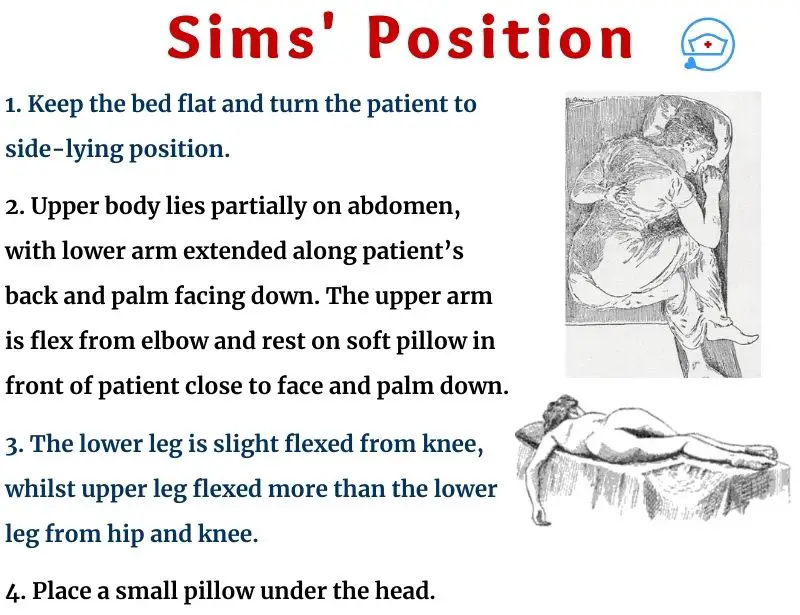Sims’ Position
The Sims’ position is also called semi-prone position. It is a combination of both the lateral decubitus position and prone position.
In the Sims’ position, the client’s upper torso is kept in the prone position and the lower part of the kept in lateral position (procedure steps are explained below). Traditionally this position was commonly used in childbirth and gynecological procedure.
The indication for sims’ position is similar to the lithotomy position. i.e., it is used in gynecologic, rectal, and urologic exams, procedures, and surgeries.
Sims’ position also offers a clear view, free movement for the surgeon, and easy access to the site. Additionally, it is more comfortable and saves embarrassment for the patient.
Most common nursing procedures which involve patient positioning to Sims’ position include administering enema and suppository insertion. Also, this position is used for obtaining rectal body temperature.

History of Sims’ Position
The Sims’ position is named after a famous American Surgeon Dr. James Marion Sims. He was born in 1813 in Lancaster County, South Carolina, and known as the ‘Father of Gynecology’.
Dr. Sims is also known for his innovative surgical skills and techniques. He successfully and consistently repaired vesicovaginal fistulae using Sims’ position. The Sims’ speculum, which is a commonly used instrument in vaginal examinations is also invented by Dr. Sims.
Definition
The Sims’ position can be described as the patient’s torso in the prone position, lower arm lies along the back and upper arm forward. While lower extremities are in lateral position. The lower leg is slightly flexed from the knee and the upper leg is flexed towards the chest more than the lower leg.
Purpose
The purposes/indication for Sims position are:
- It is used for per-rectal examinations.
- It is used for labor and postpartum perineal examinations.
- It is used for administering enemas and suppositories.
- Unconscious patients for drainage of fluids from mouth to prevent aspiration.
- It is used for paraplegic and bedridden patients to reduce pressure on the sacrum and greater trochanter of the hip to prevent sacral decubitus ulcers (bedsores).
- The exaggerated Sims’ position is indicated in cord prolapse
How to position patient in Sims’ position?
Following are the steps nurses follow to keep patients in Sims’ position for dependent patients. For independent patients, you can verbally explain and guide as needed. Also, modifications and adjuments are made to the positioning as per the procedure to be performed.
| Steps | Rationale |
| Explain the procedure | – |
| Straighten the bed completely | Promotes correct body alignment of the patient before repositioning |
| Keep the patient in the supine position. First, turn his/her torso while supporting shoulders, then turn lower body while supporting the hips to the lateral position. | Helps to prepare the patient for repositioning with ease |
| Upper body lies partially on the abdomen, with the lower arm extended along the patient’s back. The upper arm is flexed from the elbow and rests on a soft pillow in front of the patient. The lower leg is slightly bent from the knee, whilst the upper leg flexed from the hip and knee about 90 degrees and rests on a soft pillow. | Pillow under the hand, helps to maintain correct alignment and prevents internal rotation of the shoulder. Pillow under the leg with hip helps to prevent internal rotation of the hip and adduction of the leg. Also, decreases pressure on the knees and ankles by the mattress. |
| Put a small pillow under the patient’s head. | Promotes proper body alignment and prevents lateral neck flexion. |
| Provide foot support with sandbags. Keep it parallel to the plantar surface of the foot. | Helps to keep the foot in dorsiflexion and prevents footdrop and contractures. |
Advantages of sims’ position
Advantages compared to lithotomy position include:
- More comfortable to the patient with much less embarrassment
- It allows free movement for the surgeon
- It gives better visualization of all of the vagina during sims’ speculum examination
- It provides clear view for biopsy or smears of the cervix
- It allows visual assessment and helps determining the degree of cystocele, rectocele and uterine prolapse
- It prevents aspiration in unconscious patients
Variations of Sims’ position
Like many other positions, Sims’ position also has different variations which adopts according to the procedure to be performed. Commonly used sims’ position in the clinical setting include, left Sims’ position (left semi-prone position), right Sims’ position (right semi-prone position), modified Sims’ position, and exaggerated Sims’ position.
If you are a bit dyslexic with left and right, here is a quick tip to identify whether the patient is in either right or left Sims’ position. Always see which side of the patient’s body is lying on the bed.
i.e., if the patient is lying on his/her left arm and leg on the bed means it’s left Sims’ position. If it’s his/her right arm and leg then it means the patient is on right Sims’ position. This also applies to lateral decubitus (side-lying) positions.
Left Sims’ position
The left Sims’ position is also called the left semi-prone position and left lateral Sims’ position. It is the most commonly used position amongst all the different Sims’ positions.
The left Sims’ position is commonly used for administering enemas, suppositories, and procedures such as rigid sigmoidoscopy.
How to place the patient in left Sims’ position?
To place position in the left Sims’ position,
- keep the bed flat and turn the patient to left lateral position.
- upper body lies partially on abdomen, with left arm extended along patient’s back and palm facing down. The right arm is flex from elbow and rest on soft pillow in front of patient close to face and palm down.
- the left leg is slight bent from knee, whilst right leg flexed from hip and knee about 90 degrees and rests on soft pillow.
- place a small pillow under the head.
Right Sims’ position
The right Sims’ position is also called the right semi-prone position or right lateral Sims’ position. This position can be used to rest and reposition bedbound patients.
To place the patient in right Sims’ position you follow the same steps as the left Sims’ position except for this time you turn the patient to his/her right side-lying position. So, the lower arm and leg are right.
Modified sim’s position
Modified Sims’ position is usually used in obstetric procedures such as childbirth and fetal scalp blood sampling.
According to a study, maternal modified Sims’ position on fetal supine side is an effective position to adopt during labor. Because it helps in the rotation of persistent fetal occiput posterior (POP) position. Thereby, promoting safer vaginal delivery to the baby and the mother.
This obstetric modified Sims’ position creates asymmetry in the pelvis. Thus, increasing the middle and lower pelvic diameter. Also, allow free movement of the sacrum.
How to achieve modified Sims’ position?
Following are the steps to place patient pregnant women in modified Sims’ position.
- Keep the client in lateral decubitus position same as fetal spine – right of left lateral decubitus position is determined based on the fetal spine
- Place single small comfortable pillow under the head
- Both arms in front of the client slightly bent from elbow as per her comfort
- Keep lower leg stretched out. While the upper leg flexed forward and is placed on stirrup, and knee hyper flexed at 90 degree with slight internal hip rotation.

Exaggerated sims position
Exaggerated Sims’ position is used during cord prolapse. Knee-chest position is also used in patients with cord prolapse. But exaggerated Sims’ position is preferred over knee-chest position especially if the patient needs to be transferred from one place to another place.
How to achieve exaggerated Sims’ position?
Steps to place the patient in exaggerated Sims’ position are as follows.
- Keep the patient in left lateral decubitus position with upper body in semi-prone position.
- Right arm in front of the patient while left arm lies behind the patient.
- Upper leg (i.e. right leg) flexed from hip and knee and pulled towards chest. While left leg (i.e. lower leg) is stretched out.
- Elevate patient’s left hip area with supportive device such as pillow
- Additionally, Trendelenburg position may be assumed with exaggerated Sims’ position to enhance effectiveness of the position.
When should Sims’ position be avoided?
The Sim’s position should be avoided in patients with deformities of the hip or knee with limited range of motion. Usually, it’s difficult for elderly patients to use as a resting position.
Sims’ position (semi-prone position) vs lateral decubitus position (side-lying position)
Sims’ position (semi-prone position) is also a variation lateral decubitus position. Both positions are differentiated by how the bodyweight is distributed when the patient is in position. Also, typically the lower arm lies along the patient’s back in the Sims’ position.
In the sims’ position, the patient’s weight is on the anterior aspect of the patient’s shoulder girdle and hip.
On the other hand, when the patient is in true lateral decubitus position bodyweight is more equally distributed on the side patient which is lying. Also, both arms are always placed in front of the patient.
Documentation tips
- Frequency of repositioning and moving
- Exact position used and
- Assisted devices used for positioning
- Assistance required
- Patient’s response
Conclusion
To conclude, Sims’ position is commonly used for gynecologic and obstetric, urologic, and colorectal examinations, procedures, and surgeries. It allows better visualization and free movement for the surgeon during the procedure. At the same time, it promotes comfort and less embarrassment for the patient.
Nurses often use Sims’ position for procedures such as obtaining rectal body temperature and administering enemas and suppositories.
Patient Positioning for Nurses
Lithotomy Position |Indication |Variations |Nerve injuries
Sims’ Position |Purpose |variations |procedure
Dorsal Recumbent Position |Definition |Uses |Image
Reverse Trendelenburg Position |Complications |Indication |Benefits
Reference
Boyle, M. (2011). Emergencies Around Childbirth: a handbook for midwives (2nd ed.). Radcliffe Publishing.
Freeman, R., Garite, T., & Nageotte, M. (2003). Fetal Heart Rate Monitoring (3rd ed.). Lippincott Williams and Wilkins.
Funnell, R., Koutoukidis, G., Lawrence, K., & Tabbner, A. (2009). Tabbner’s Nursing Care: Theory and Practice (5th ed.). Churchill Livingstone Elsevier.
Perry, A., Potter, P., & Ostendorf, W. (2014). Clinical nursing skills & techniques (8th ed.). Mosby/Elsevier.
Servant, C., Purkiss, S., & Hughes, J. (2009). Positioning Patients for Surgery. Cambridge University Press.
Timby, B. (2009). Fundamental Nursing Skills and Concepts (9th ed.). Wolters Kluwer Health/Lippincott Williams & Wilkins.




